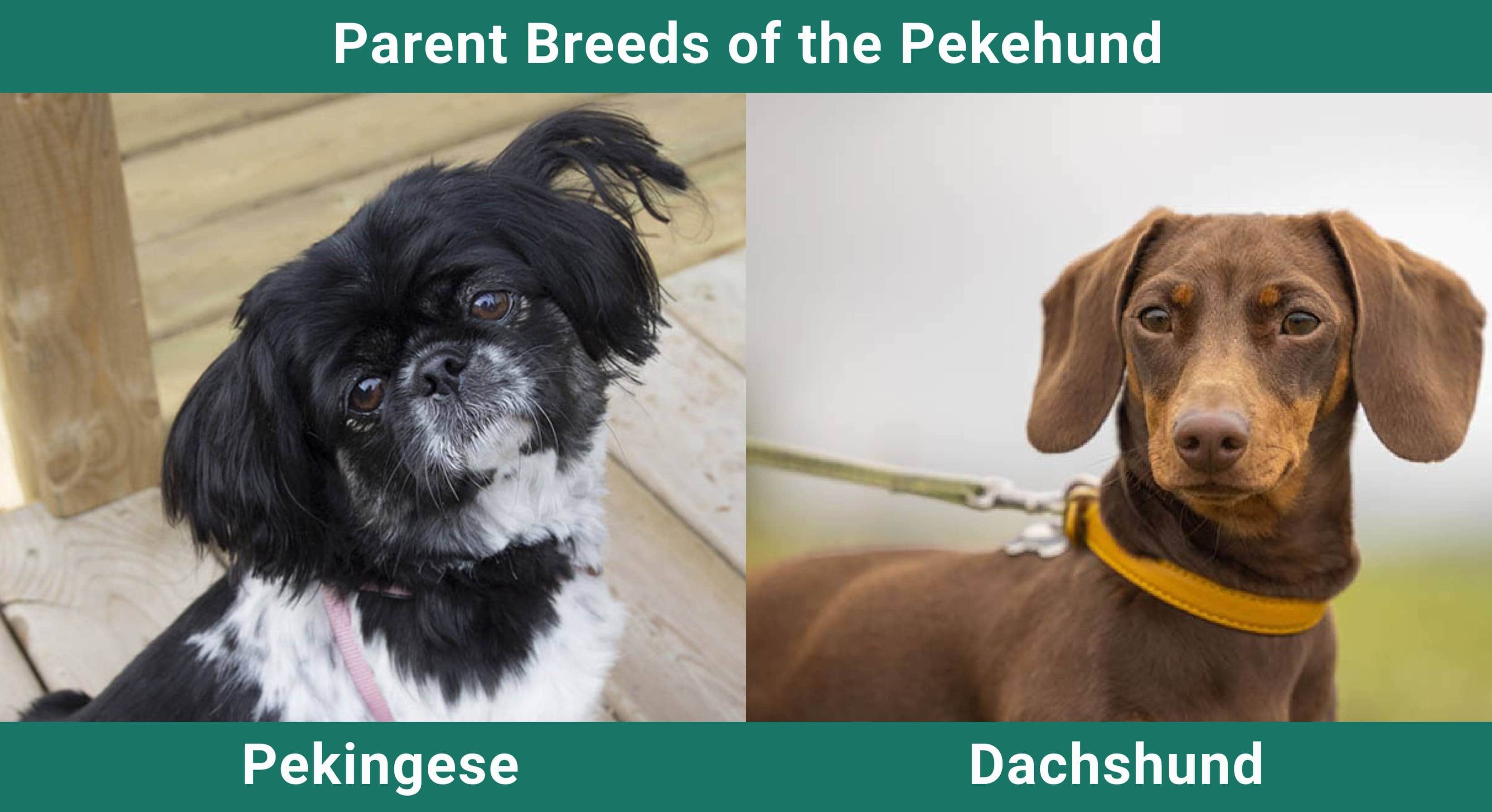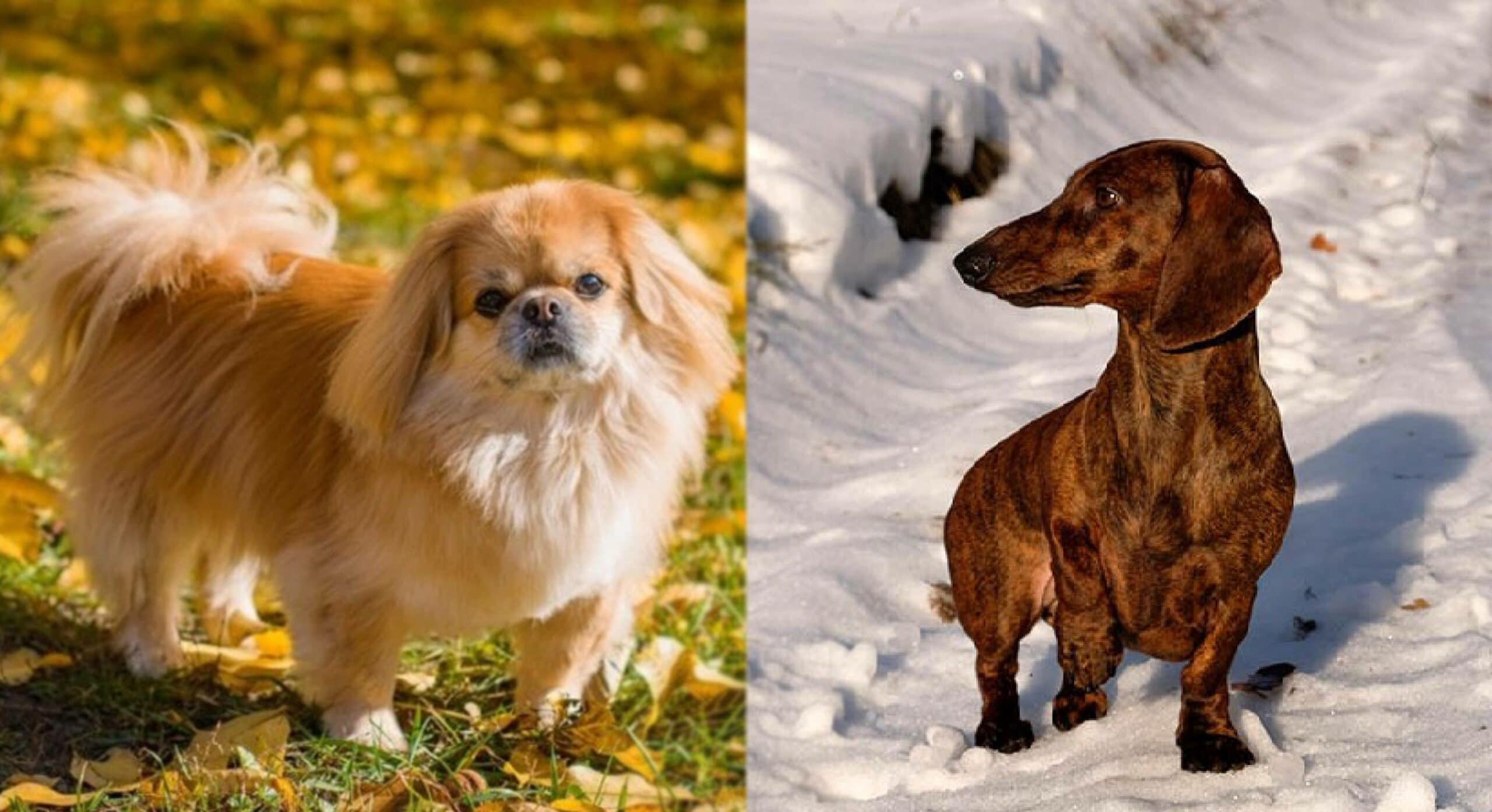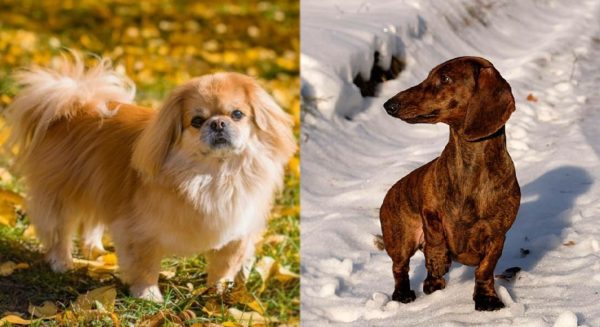Click Below to Skip Ahead
The Pekehund is an admirable combination between a Dachshund and a Pekingese. It also goes by the names Pekeashund, Pekeweenie, Dachanese or Dachshund/Pekingese Mix.
This hybrid balances out several strong traits of its parents, such as energy levels. That’s not to say it does not reinforce other characteristics. This dog is more loyal, dedicated, intelligent, and affectionate.
Breed Overview
Height:
7 – 9 inches
Weight:
10 – 20 pounds
Lifespan:
12 – 15 years
Colors:
White, tan, brown, black, cream
Suitable for:
Singles, couples, families, seniors, apartment living
Temperament:
Energetic, loyal, intelligent, loving, sweet
It is unclear why the Pekehund was created, but some breeding experts explain it was for companionship. Another reason could be to breed an attractive dog.
Either way, this designer dog has an average lifespan of 12 to 15 years and is suitable for people of all ages. Their loyal nature helps them become firm family members, but they can be stubborn, too.
The Dachanese has received recognition from American Canine Hybrid Club (ACHC), Designer Dogs Kennel Club (DDKC), Designer Breed Registry (DBR), Dog Registry of America, Inc (DRA), and International Designer Canine Registry (IDCR).
However, the American Kennel Association is yet to recognize the mix.

Pekehund Puppies
To ensure that you choose an ideal Dachshund/Pekingese Mix puppy, opt for one that is healthy both physically and mentally. Also, check whether it has the right temperament for you.
Furthermore, ask the breeder to show you the puppy’s parents. Inquire about the parents’ background and their temperament. Watch as the Pekehund puppy interacts with its siblings and parents and how they relate with you and your relatives. It is best to choose puppies that appear more energetic, friendlier, and sociable. Alert puppies are healthier compared to lethargic ones. Also, do a physical examination and check if they have bright, clear eyes, clean mouths, ears, and coats.

Temperament & Intelligence of the Pekehund
Two personality traits stand out from the Dachshund and Pekingese: they are loyal to their owners and are actual pack animals. For these reasons, it is safe to say that Pekehunds are affectionate, loving, and loyal pets.
The Pekehund is a sweet and loving dog who loves to cuddle or sleep on your lap. It is friendly, but not to strangers, and may take a while warming up to them. The dog is protective and enjoys performing funny antics.
Dachanese dogs are also quite intelligent. They require daily mental stimulation, which can be in the form of games, one-on-one interactions with family members, or getting loads of attention.
It would be best if you got to understand your pet. Keep in mind that although this designer dog is affectionate and devoted, it is also strong-willed and fearless. You may observe that it has exceptional courage and a heightened sense of territory.
Besides, you may find the dog confronting animals larger its size, which, if not monitored, can get them in trouble. The Pekehund is also stubborn, a trait that most owners don’t always point out. Their independent mind pushes them to break those rules they do not like.
This designer breed is naturally curious and can be a handful for beginners, particularly during training. However, training the puppies at an early age can prove helpful.
Are These Dogs Good for Families? 🏡
Yes. The Pekehund is known for its deep sense of attachment and loyalty to its owners. It is a people-oriented breed, and many are the times, you will find it snuggling close to its owner or other family members.
The pet is suitable for families who play non-stop or senior persons with less physical activity. However, it is worth mentioning that this hybrid dog is not ideal for families with small kids.
Owners with small kids are advised to wait until the kids are at least five years before purchasing this dog. At five years, these kids can understand how to handle and treat pets. Pekehund pups are fragile if dropped and can easily result in spinal issues.
Does this Breed Get Along with Other Pets? 🐶 😽
The Pekeweenie is a pack dog that enjoys the company of other pets. They suffer separation anxiety when left alone for too long but do well in the company of another pet. However, since they have Dachshund genes, this dog may chase smaller pets as prey.
Socialize the Pekehund with other animals to ensure that they get along.
Things to Know When Owning a Pekehund
Food & Dietary Requirements 🦴
Food is a fundamental basic need for your Pekehund as it keeps the dog happy and healthy. You need to find the best dry dog food.
Choose a dog food rich in protein, fat content, Omega fatty acids, and free of additives. Bad dry dog foods may cause gastrointestinal problems for your furry friend.
Since your pet is a small to medium-sized dog, serve them ¾ to 1 ½ cups of dry food as their daily ration. If your dog shows signs of stomach discomfort, split their meal into two. Their digestive system digests smaller portions effortlessly.
Also, limit the dog’s intake of sweets and treats as it is prone to obesity. Only choose low-calorie treats to avoid creating health problems.
Exercise 🐕
Depending on the parent the Pekehund takes after, it generally requires at least 30 minutes of exercise every day. If the dog takes after the Dachshund, it may require more activities and adventure time to gratify its hunting instincts and natural curiosity than when it takes after the Pekingese.
This little dog enjoys all activities where they are in the company of their owner. It will happily go for a walk, play fetch, or take a trip to the dog park with you. If your pet is socialized with other dogs, it will enjoy playing with them.
If you have a small yard area, allow the Pekehund to access it regularly during the day. The more active your pet is during the day, the less destructive they will be and sleep better at night.
The pet also enjoys climbing and jumping. Sadly, Pekehunds have complicated spinal problems that are easily set off by jumping from high surfaces. It would be best if you prevent your pet from climbing onto furniture and stairs.
Observe your furry pet to understand the intensity of exercises it needs to make them healthy and happy.
Training 🦮
Training Pekehund pups is much easier than training an adult dog. Early socialization and obedient training will nurture your dog’s character and behavior. Pekehunds are intelligent dogs who love attention but are not the easiest to train.
Their parents are stubborn, an inherited trait that slows down their training. To ensure that the training is successful, reward the dog with treats, gifts, or praise when they do a command right.
Avoid reprimanding, punishing, scolding, or showing cruelty when the dog disobeys. Instead, maintain a firm, consistent training schedule with a positive and patient mindset.
In addition, get the best training collars as they are effective in speeding up the training process. Lastly, assert yourself as the pack leader and always have the final say. When your pup acknowledges your position, it will be obedient and look up to you.
Grooming ✂️
Grooming rituals depend on the coat your pet inherits. If your pet has a shorter coat, weekly brushing is recommended. However, wiry and long hair requires thorough brushing twice a week.
It is common to notice feathering around the chest and ears. You can trim it with clippers or scissors. Alternatively, take your pet for professional grooming.
The dog’s ears are prone to excessive wax build-up, which leads to discomfort and infections. You ought to clean your pet’s ears with wet wipes or a prescribed solution. Also, brush the dog’s teeth daily or three times a week to keep their gums healthy.
A monthly bath is enough for a Pekehund. But do ensure that you use an all-natural dog shampoo. Trim their nails monthly, too.
Health Conditions ❤️
The Dachshund Pekingese Mix can live healthily for 12 to 15 years when raised in a conducive environment. But like other dog breeds, they suffer minor and severe health conditions.
It is recommendable that you register your pet with your vet and schedule regular check-ups. This will help pick up any health issues and immediately act on them.
- Epilepsy
- Deafness
- Diabetes
- Hydrocephalus
- Mitral valve disease
- Cushing’s disease
- Patellar luxation
- Skin fold dermatitis
- Bloat
- Entropion
- Intervertebral disc degeneration
- Brachycephalic syndrome
- Exposure keratopathy syndrome
- Progressive retinal atrophy
Male vs Female
Male Pekehunds may grow a few inches taller than females. The males are generally 8 to 12 inches while females grow to 10 inches. In terms of weight, females weigh between 10 to 20 lbs. but males can get to 25 lbs.
There are no differences in personality and temperament between the two genders.
3 Little-Known Facts About the Pekehund
1. The Dachshund and Pekingese have Different Histories
The Pekehund parents come from opposite backgrounds. The Dachshund hails from Germany and is believed to have existed from the 15th century. The dog was bred to hunt badgers, den animals, or larger animals when in packs.
Over the years, breeders altered it into a fearless and elongated dog to quickly dig into burrows. In the 1800s, the Dachshund was bred to become a companion. It arrived in America at the end of the 19th century.
On the other hand, the Pekingese is at least 2,000 years old and originates from China. It got its name from the then Chinese capital, Peking.
The breed was exclusive to China and only left the state during the Opium war in 1860. The British brought the Pekingese with them to England. It eventually spread to the U.S at the beginning of the 20th century.
2. There is a Story Behind the Origin of the Pekingese
As the story goes, the Pekingese is a cross between a lion and a marmoset. The two fell in love, but they were naturally incompatible.
The lion requested Buddha to change its size but leave its brave heart and great character. Legend has it that the Buddha did make the lion smaller and the two sired Lion dogs or Fu Lin, now known as Pekingese dogs.
The elite and royal families originally owned this dog as they believed it had powers to protect them from evil spirits. Unfortunately, not much is known about the breed due to incomplete breeding records.
3. Dachshunds are also Called Sausage Dogs
The Dachshunds earned the name sausage dogs due to their elongated bodies. Their appearance also features floppy ears, short legs, and long tails.
Final Thoughts
The Pekehund is a joyous addition to any home. It is adaptable, people-oriented, happy, sweet, and affectionate. They are a great companion for singles, couples, or seniors as they do not demand much.
This hybrid dog is relatively easy to train and groom. It has a lot of pent-up energy but tires quickly, making it suitable for apartment living. The Pekehund is an ideal watchdog and tends to growl and bark at strangers.
The crossbreed can live healthily for up to 15 years. However, only buy the breed from reputable breeders and avoid puppy mills at all costs!
Featured Image Credit: Counselling, Pixabay










